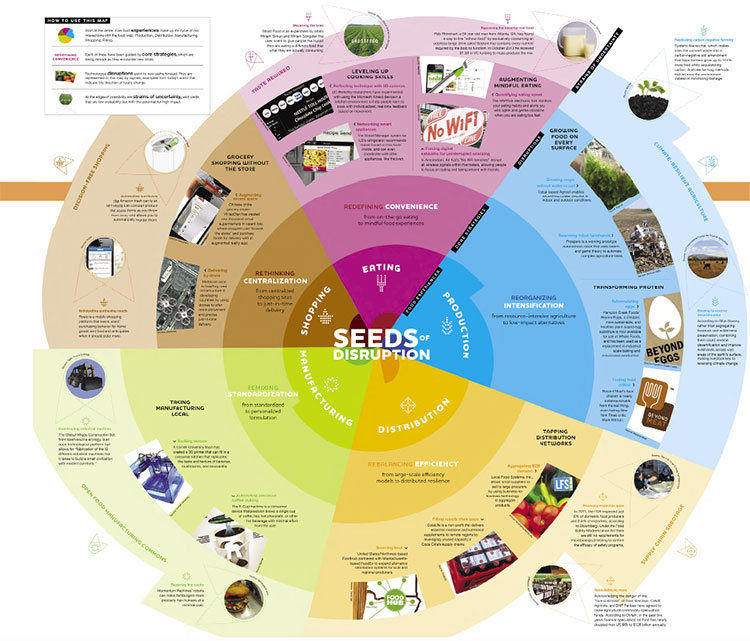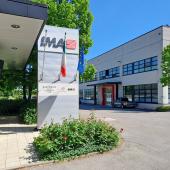“Seeds of Disruption” in the agrifood chain: global prospects for innovation in the food system
In collaboration with IFTF - Institute for the Future, Palo Alto, Matteo Vignoli and his team have developed the “Seeds of Disruption Forecast Map”, a concept map that investigates the ways in which technological innovation, formulated and implemented through the collaboration between the actors of the agrifood chain, is remodeling the sector at a global level.
Vignoli’s studies show how the experiences related to food are above all of a professional nature: in fact, the phases of the supply chain involve farmers, scientists, innovators, developers and entrepreneurs, to cite only some of the players who actively take part in the sector’s strategies.

Evolution of the food system
In recent decades, the complex food system of the planet has evolved in pursuit of urgent needs, intensifying production, making distribution efficient and standardizing the procedures and characteristics of the final products.
Even the purchasing experience has changed over time through centralization and, ultimately, the consumer experience still sees convenience and affordability as a priority. These strategies have been refined for decades, but today they show their greatest limitations. Technological innovations, if implemented and shared between customers and suppliers in the supply chain, contribute to radically transforming the experience related to food, responding to the new needs of the planet and the world population. The Seeds of Disruption map has been conceived as a tool for dialogue, precisely with the aim of illustrating how emerging technologies can be used in all stages of the supply chain.
Innovation, if developed together and pursuing a common goal, is able to redefine the strategies and relations between the different actors involved in each phase of the agrifood chain, helping to respond to the new needs of the planet and consumers, where efficiency and sustainability are and will be sector bywords.
Create change, overcoming limits
How does one produce enough food to feed the planet with a constant population growth? How does one avoid wasting resources to produce food, and how does one obtain higher quality food products and make distribution more effective?
The study by Professor Vignoli answers many questions, spelling out strategies for the future via the map, dividing them into five crucial areas that correspond to the levels of the supply chain.
The limits currently found for each step are revealed, and possible innovative solutions are proposed to overcome them.
Production
Current limit: an excessive ground and primary resource use required for intensive production and an ever widening gap between what we produce and what we really need.
Target: reorganize the intensification.
Possible solution: Go from intensive agriculture, accused of over-exploiting natural resources, to an agriculture that uses low environmental impact alternative resources. Technological innovations enable the reorganization of production and the management of the real need for abundance.
Distribution
Current limit: distribution on a global scale has negatively affected the environment and the quality of the product. Efficient distribution management is often inflexible and fragile.
Target: rebalance efficiency.
Possible solution: move from e largescale distribution efficiency models to regional and local distribution, ensuring greater product quality.
Converting
Current limit: products distributed on a global scale are subject to greater processing to meet the necessary standards, also standardizing the ingredients.
Objective: remix the standardization.
Possible solution: product processing will have to be more transparent, to respond to ever greater consumer needs.
Shopping
Current limit: the weekly purchase of products in a single shopping center (supermarket) no longer meets the needs of the modern consumer.
Target: redesign centralization
Possible solution: an increasing support for the availability of digital alongside physical purchasing platforms.
Eating
Current limit: the need for speed and convenience in consumption has increased the purchase of convenience foods and the proliferation of the concept of fast food. This lifestyle, if adopted habitually, has serious health consequences.
Target: redefine the concept of convenience
Possible solution: educate towards a mindful food experience.
The opportunities to overcome the boundaries that inextricably link the stages of the supply chain are deeply interrelated and new technologies can be used successfully when formulated together, through dialogue and sharing between customers and suppliers in the supply chain, creators of the future of the sector. The relationship between customers and suppliers who choose to follow the Design Thinking approach puts people at the center via a continuous interaction, capturing the most profound and latent needs of the various interlocutors, in order to offer them the best solutions.

Fourth edition of the Verallia Design Award
For the contest promoted by Verallia, the students of the Poli.Design 1090 traineeship Workshop, Consortium of the Milan Polytechnic and of the Milan Polytechnic degree course in industrial product design - Design schools tackled an industrial project that responds in all effects to real business needs: in fact, they had to propose projects for new glass bottles for Lurisia and Santero, partners in the competition and involved in the jury.
The winning projects were proclaimed during the “Disruptive Innovations in Food and Beverage” event of 17 October.
Ace Black. Santero’s pop soul was the main source of inspiration for Lucia Gualdi and Francesca Inzani, who designed a bottle for sparkling wine with a fluid and slender shape contrasting with the geometry of the colored rhombuses of the pattern. Clear assonance between the Santero logo and the ace of diamonds of the cards.
Mate. In turn the “high end” bottle designed by Aurora Baratto and Alessia Kayalibay for Lurisia drinks plays on the contrast between shiny and sati, aiming to enhance the contents with special visual effects.
For more information
www.iftf.org/our-work/global-landscape/foodforfuture/seeds-of-disruption
www.iftf.org/fileadmin/user_upload/ downloads / food / IFTF_SeedsofDisruption_Map.pdf

















